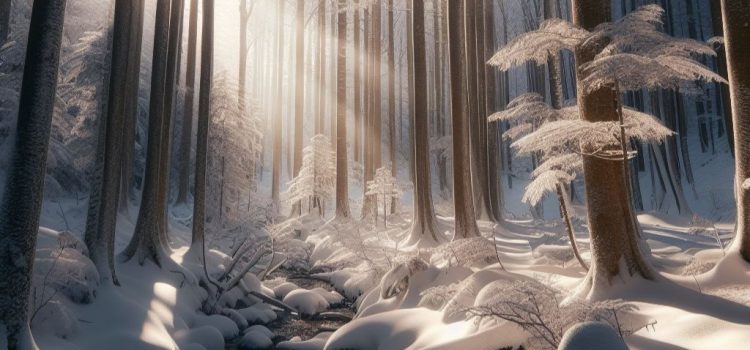
This is a free excerpt from one of Shortform’s Articles. We give you all the important information you need to know about current events and more.
Don't miss out on the whole story. Sign up for a free trial here .
How do trees survive in winter? How can they withstand the cold? In what ways do trees cooperate?
Trees live on little more than sunlight, water, and the nutrients they draw from the soil. They respond to changes in the seasons and weather even the harshest winters. Recent research indicates they may be less solitary than they appear, and may help each other survive the cold.
Here’s a look at the science behind how trees survive winter.
What Do Trees Do All Winter?
As spring awakens the forests around us, trees shake off their dormant states and come to life after having spent several months in seemingly quiet solitude. Recent studies have shed light on how trees survive winter, revealing some unusual characteristics and showing that even in the coldest months of the year, they’re surprisingly active.
The Science of Trees in Winter
Trees contend with many challenges in the winter. The weight of ice and snow or the battering of the wind can break limbs. Freezing temperatures can crack wood. The sap inside trees can even freeze, pressuring the bark from inside until it explodes and breaks the branch or trunk. Nonetheless, trees can survive hundreds—or even thousands—of winters in their lifetimes.
When deciduous trees (trees that shed annually) drop their leaves, they stop pulling water up from their roots into their trunk and branches. This allows their living cells to shrink and dehydrate, reducing their water content and concentrating their sugars—both of which protect cells from freezing.
Evergreen trees don’t drop their needles in the winter—needles, which are essentially rolled-up leaves, are glazed with a waxy coat that reduces the amount of water that evaporates, thus lessening the need for the tree to continue pulling water up from the ground. Even with this advantage, evergreens still, like deciduous trees, undergo changes to further reduce their internal water content by moving water out of their living cells and into the spaces between cells to prevent damage from freezing temperatures.
Both types of trees also produce proteins that act as antifreeze, and some trees distribute chlorophyll beneath their bark, especially under the thin bark of their youngest branches, so they can continue photosynthesis to eke out nutrients to survive the winter.
Once they’ve survived a winter, trees can repair some damage they’ve sustained. They first release antimicrobial and antifungal chemicals to prevent injuries from becoming infected, and they then construct calluses to close their wounds and protect them while they heal.
Trees Cooperate by Sharing Resources
In his book The Hidden Life of Trees, forester Peter Wohlleben delves deep into the world of old-growth forests. He says that trees in a forest function as critical support systems for each other, particularly when it comes to weathering severe environmental conditions, like winter. Older trees provide shelter for younger ones, creating a canopy that offers protection from harsh weather. Then, when younger trees are more established, older trees die, creating space for smaller trees to grow. Together, they form a communal living space, mitigating the harshness of the weather and creating small local climates that support their survival.
Additionally, writes Wohlleben, trees in a forest exhibit a remarkable level of cooperation in sharing nutrients. They maintain a uniform rate of photosynthesis, hinting at a shared system of nutrient distribution. Wohlleben attributes this to an intricate underground network of roots and beneficial fungi that work in tandem to extract and distribute essential nutrients, especially sugars, from the soil. This system functions much like the diverse organisms within the soil that decompose organic matter and recycle nutrients, contributing to maintaining a healthy and sustainable ecosystem.
Trees Cooperate With Other Species
Wohlleben says that trees don’t just cooperate with other trees but also have reciprocal relationships with other organisms, like fungi. Unlike trees, fungi can’t photosynthesize independently. Instead, they form organic connections with plants, like trees, to receive essential sugars and other carbohydrates. In return, the fungi spread through tree roots, creating an extensive mycelial network that dramatically increases an individual tree’s root surface area, allowing it to absorb more water and nutrients. The mycelial web also interconnects the roots of various trees, promoting nutrient exchange among them. Fungi also act as guardians for their tree partners, filtering out toxins and warding off harmful bacteria or other antagonistic fungi.
None of this cooperation is possible if a tree is isolated, says Wohlleben. These relationships only occur in natural forests. An individual tree can’t build a friendly microclimate, moderate temperature, protect seedlings from a storm or unrelenting sunlight, or share nutrients. Forests that have been planted by humans also fail to replicate this intimate network. As Wohlleben points out, planted trees often have damaged root systems that fail to create the rich root networks characteristic of long-standing forests.

Want to fast-track your learning? With Shortform, you’ll gain insights you won't find anywhere else .
Here's what you’ll get when you sign up for Shortform :
- Complicated ideas explained in simple and concise ways
- Smart analysis that connects what you’re reading to other key concepts
- Writing with zero fluff because we know how important your time is






